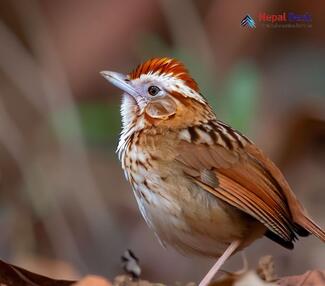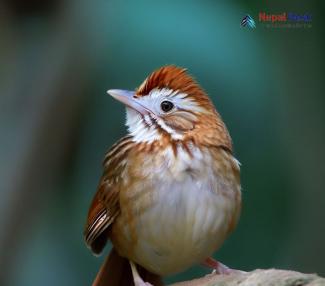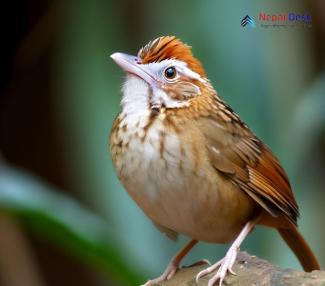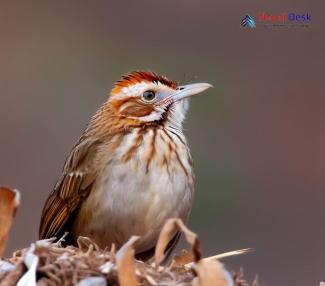The Puff-throated Babbler, an enchanting small bird, has captured the attention of bird watchers and researchers alike. This mesmerizing avian species can be discovered across various regions in Asia, including the breathtaking scenery of Nepal. In this article, we take a closer look at the unique features and alluring presence of the Puff-throated Babbler amid the diverse ecosystems of Nepal.
Puff-throated Babbler's Characteristics
Measuring approximately 15-18 centimeters in length, the Puff-throated Babbler (Pellorneum ruficeps) is a petite bird. Its appearance is marked by a predominantly brown and buff-colored coat with a bold black-and-white streaked throat. During vocalization, its throat exhibits a distinct "puffed" appearance.
One of the most fascinating aspects of the Puff-throated Babbler is its tuneful song, which fills Nepal's forests with delightful melodies. Males sing to establish their territory or woo potential mates, employing a series of harmonious whistles and trills as part of their performance.
Puff-throated Babbler's Presence in Nepal
Nepal offers an idyllic habitat for the Puff-throated Babbler, courtesy of its forested areas with dense undergrowth that create ideal breeding territories. This avian species can be spotted inhabiting Nepal's lowlands up to elevations around 2000 meters. Popular sighting spots include Chitwan National Park, Bardia National Park, and Shivapuri Nagarjun National Park.
Apart from Nepal, this species also ranges across other South Asian countries like India, Bangladesh, Bhutan, Sri Lanka, and Myanmar.
Diet and Mating Rituals
Feeding primarily on insects, larvae, and occasionally seeds or small fruits, the Puff-throated Babbler forages mostly on the ground. They display a peculiar foraging skill where they flip leaves using their beaks to reveal concealed prey.
The breeding season generally falls between March and September, although some regional differences may arise. Building a dome-shaped nest either on the ground, or low within shrubs or grass clumps, these birds use grass, leaves, and roots as construction materials. Incubation responsibilities for the 2-3 eggs are shared between both parents.
A Word on Conservation
Listed as "Least Concern" on the IUCN Red List, the Puff-throated Babbler benefits from its vast distribution and steady population figures. However, habitat loss and fragmentation arising from human activities could potentially threaten their population in the future, underscoring the importance of preserving their natural habitats.
In conclusion, the Puff-throated Babbler is a captivating bird species that undeniably contributes to Nepal's vibrant biodiversity. The charming melodies of this elusive bird play a vital role in composing nature's unique symphony that enthralls anyone exploring Nepal's lush forests. By safeguarding their habitats and appreciating their existence, we can guarantee that future generations continue to relish the splendor and fascination brought about by these intriguing birds.




